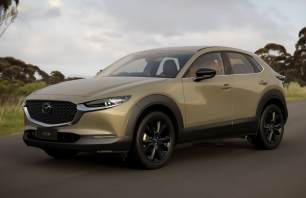There’s a reason most supercars aren’t daily drivers, and it’s not always just a financial one.
It’s because they’re the most specialist tools in the automotive toolbox, usually engineered to attack race tracks and alpine roads, but not the school run or bumper-to-bumper traffic.
But you put up with it — the too-firm ride, the questionable ergonomics — because when you do land upon the kind of road your car was built for, any other inconvenience vanishes like traces of smoke from a chimney.
Which is exactly what makes the Purosangue such an interesting proposition, because here is a Ferrari that will likely be driven more, and for longer spells, than any Ferrari to have come before it, but it still needs to excite the senses on the right road.
So has Ferrari pulled it off? In a word, yes.
Honestly, when you’re just tootling around it’s easy to forget you’re driving a supercar.
That V12 engine falls silent, the exhaust is almost non-existent (owing largely to the sound deadening of the cabin – to really hear this beast at full roar you want to crack a window, or find a tunnel), and the suspension (each driving mode has two suspension settings, medium and soft, allowing for some serious fine-tuning of the ride comfort) floats across most road surfaces.
It feels much like any other premium SUV, and not one with a nuclear power plant lurking just ahead of the dashboard.
Because there is a Hyde to this Jekyll, and it arrives when you dial up the sportiness, or get a little too heavy with the accelerator. Then that big V12 roars into life, along with the exhaust, and suddenly you’re very much behind the wheel of Ferrari once again.
Engage launch control and you can feel the Purosangue hunker down, dropping lower onto the wheels and readying for action. Flatten your right foot, and 100km/h arrives in a claimed 3.3 seconds, with 200km/h flashing by in 10.6 seconds.
But there is a quirk here, and that is that the Purosangue doesn’t always feel blisteringly fast. It's powerful, sure, and plenty quick, too, it's just that somehow it doesn't always feel quite as fast as the spec sheet suggests.
Maybe it’s the theatre, or all in my mind, but I reckon the best way to experience the all-out performance is by taking over the gearing yourself, and listening to the machine-gun-popping of the rev limiter before squeezing the paddle shifter, to truly feel like you're unlocking every ounce of performance on offer.
Is it the sharpest Ferrari ever built? Obviously not, and even a carbon-fibre roof can’t compensate for the over 2.0-tonne weight here.
But I promise, should you find yourself on a twisting road, the Purosangue can paint a supercar-sized smile on your face just the same.
The steering isn't quite as sharp as it might be in a true supercar (I suspect its been softened to make the Purosangue more comfortable on freeways and over longer distances), but it still inspires plenty of confidence, while the the rear-wheel-steering helps tuck you nearly into corners before that big engine drags you out the other side, that operatic exhaust bellowing along with you.
A real Ferrari? You bet.

